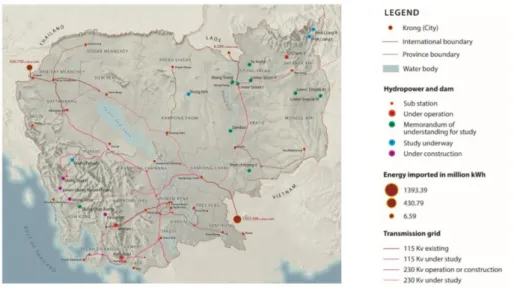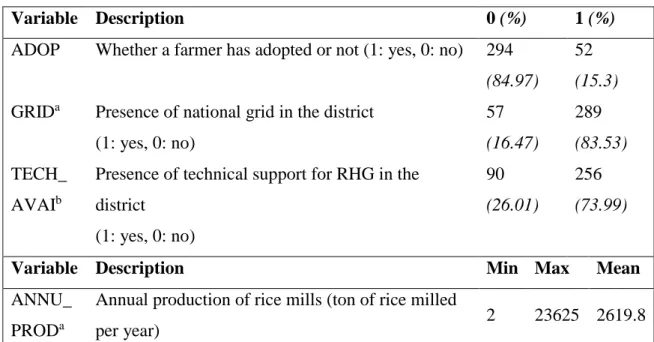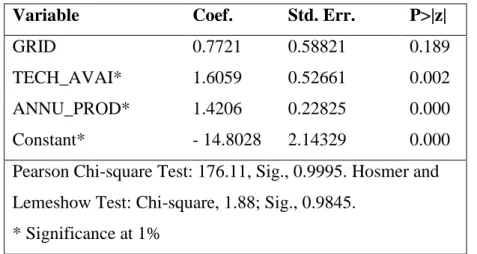HAL Id: hal-01422206
https://hal.archives-ouvertes.fr/hal-01422206
Preprint submitted on 24 Dec 2016HAL is a multi-disciplinary open access archive for the deposit and dissemination of sci-entific research documents, whether they are pub-lished or not. The documents may come from teaching and research institutions in France or abroad, or from public or private research centers.
L’archive ouverte pluridisciplinaire HAL, est destinée au dépôt et à la diffusion de documents scientifiques de niveau recherche, publiés ou non, émanant des établissements d’enseignement et de recherche français ou étrangers, des laboratoires publics ou privés.
Biomass gasification in Southeast Asia: Factors
influencing technology adoption in Cambodia
Hong Nam Nguyen, Hoai-Son Nguyen, Minh Ha-Duong, Laurent van de
Steene
To cite this version:
Hong Nam Nguyen, Hoai-Son Nguyen, Minh Ha-Duong, Laurent van de Steene. Biomass gasification in Southeast Asia: Factors influencing technology adoption in Cambodia. 2016. �hal-01422206�
Biomass gasification in Southeast Asia: Factors influencing technology adoption in Cambodia
Hong Nam Nguyen1*, Hoai Son Nguyen2, Minh Ha-Duong1,3, Laurent Van de Steene1,4 1 Department of Renewable Energies, University of Science and Technology of Hanoi, 18
Hoang Quoc Viet, Cau Giay, Hanoi, Vietnam; Email: nguyen-hong.nam@usth.edu.vn
2 Economics Faculty - National Economics University, 207 Giai Phong, Hai Ba Trung, Hanoi,
Vietnam; Email: hoaisonkt@gmail.com
3 The international research center on environment and development, National Center for
Scientific Research, 45 bis, avenue de la Belle Gabrielle, 94736 Nogent-sur-Marne Cedex, France; Email: minh.haduong@gmail.com
4 The Agricultural Research Centre for International Development, Avenue Agropolis, 34000
Montpellier, France; Email: laurent.van_de_steene@cirad.fr * Corresponding author (e-mail: nguyen-hong.nam@usth.edu.vn)
Acknowledgement:
We are grateful to the SNV Netherlands in Cambodia, Cambodian rice mill owners and the Federation of Rice Millers’ Association and informants for providing very helpful data, information and feedback.
1 Abstract:
Electricity price in Cambodia is among the highest in the region due to limited fossil resources. The national grid provides electricity with cheapest tariff, from $0.11 to $0.27 per kWh, but only 25% of Cambodians are having access to it. Since 2003, scores of rice mills have installed rice husk gasification systems (RHGs) to produce electricity with a cost from $0.06 to $0.27 per kWh. RHG development is showing signs of slowing down while national grid is continuing to expand its supply area. The study was carried out to identify some factors influencing RHG adoption in Cambodian rice mills, based on data of rice mills (n=396) and report on power sector of the Kingdom of Cambodia in 2015. Field trips to rice mills (n=8) and interviews with RHG stakeholders (n = 66) were also conducted. Results indicated that technical support for RHG and annual production of rice mills had positively influenced adoption of RHG. In contrarily, results showed an insignificant correlation between the presence of national grid and RHG adoption. This study will help planners, policy makers, researchers and farmers prioritize factors affecting RHG adoption decisions and hence provide insight on pathways to increase RHG adoption.
2 1. Introduction
The price of electricity in Cambodia is among the highest in the Southeast Asia region due to limited domestic fossil fuel resources. The state-owned electricity provider Electricité du Cambodia (EDC) provides electricity with cheapest tariffs, ranging from $0.09 to $0.25 per kilowatt-hour (kWh). However, only 25% of Cambodians are having access to EDC national grid (Electricity Authority of Cambodia, 2015). Other domestic suppliers use diesel as fuel and supply electricity at tariffs between $0.75 and $1 per kWh. This has led people living in areas without access to the EDC grid to try new technologies to produce electricity at a lower cost.
Since 2003, scores of Cambodian rice mills have installed rice husk gasification systems (RHGs) in rural areas to produce electricity to run their milling machinery with a cost from $0.06 to $0.27 per kWh (Ngin, 2014; Nguyen, Ha-Duong and Van de Steene, 2015). Rice husk, a by-product of the milling process, is an abundant source of biomass in Cambodia, with 2 million tons produced in 2014 (Pode, Diouf and Pode, 2015). Biomass gasification is a thermochemical conversion process that converts biomass into a carbon monoxide and hydrogen rich-gas called synthesis gas, or syngas. Syngas can be utilized to produce heat, electricity or fuel transportation. Some different generic types of gasifiers have been developed for the conversion of biomass feedstock, namely fixed bed, fluidized, entrained flow and muti-stage gasifier. All RHGs in Cambodian rice mills are down-draft fixed bed gasification systems (Ha-Duong and Nguyen, 2014; Ngin, 2014), imported or manufactured locally. The RHG technology has been showing a high potential for small and medium power production. Nevertheless, the technology development proceeds slowly because of both technical and non-technical brakes.
RHGs arrived on off-grid regions where electricity was produced by using diesel with a very high price. But recently the Cambodian government is doing efforts to expand the national grid network. Prices are more or less the same between electricity from national grid and RHG. Does national grid then affect RHG adoption? It is less interesting to produce electricity independently if it can be bought. Very few researches have been carried out on electrification using RHGs in Cambodia (Abdul Salam, Kumar and Siriwardhana, 2010; Akgün and Luukkanen, 2012; Pode, Diouf and Pode, 2015), and literature data seems to be lacking in identifying the factors influencing the adoption of this technology. The aim of this paper thus was to identify factors influencing RHG adoption in Cambodian rice mills with the focus on the presence of the national grid.
3 2. Methodology
2.1. Data source
The data on Cambodian national grid used to examine the RHG adoption model was obtained from the report on power sector of the Kingdom of Cambodia in 2014 provided by Electricity of Cambodia (Electricity Authority of Cambodia, 2015). For Cambodian rice mills, we used the cross-sectional data of 396 rice mills provided by the Federation of Cambodian Rice Millers Associations. This data provides a wide range of characteristics of rice mills as well as RHG installations.
2.2. Modelling RHG adoption
Binary logistic regression is a popular statistical technique in which the probability of a dichotomous outcome (e.g. adoption or non-adoption) is related to a set of explanatory variables and has been widely applied in adoption studies (Adesina and Chianu, 2002; Chianu and Tsujii, 2004). In this research, rice mills’ adoption of RHG is based on an assumed underlying utility function. According to this theory RHG will be adopted by the rice mill, if the utility obtained from RHG adoption exceeds that of non-adoption. The rice mills’ behaviour towards RHG is described by Eq.1:
ln ( 𝑃𝑖
1 −𝑃𝑖) = ln(𝑜𝑑𝑑𝑠) = 𝛽0+ ∑ 𝛽𝑘𝑋𝑘𝑖 𝑛
𝑘=1 + 𝜀𝑖 (1)
where 0 is the intercept term, and 1, 2,…, i are coefficients associated with each explanatory
variable X1, X2,…, Xk. Gathered in a vector X, these factors explain the RHG adoption
decision, or the probability that the ith rice mill adopts RHG.
4
2.3. Variables selection for modelling
For the purpose of selecting variables for RHG adoption model, in addition to desk research on rice husk gasification, we conducted 2 field trips to Cambodia, in December 2014 and May 2016. Nine rice mills in Phnompenh, Kompong Thom, Kompong Speu and Siem Reap regions were selected for the field trips. The rice mills were selected based on the difference of processing capacity: from micro (milling capacity inferior or equal to 1 ton of paddy per hour), small (between 1 and 3 tons per hour), medium (between 3 and 10 tons per hour) to big size (superior to 10 tons per hour). This selection was designed in order to gather diverse types of information on the actual Cambodian rice milling sector and the actual status of RHGs.
Interviews with Cambodian stakeholders (n = 66) of RHG projects during the field trips were also conducted. Informants included rice mill owners, gasifier manufacturers and users, experts from non-governmental organizations (SNV and GERES), Institute of Technology of Cambodia, representatives of the Canadia Bank and the Federation Cambodian Rice Millers Association. Information obtained through interviews was then screened and classified by potential factors that can impact adoption decisions of RHG for rice mills, and was served as the basis for the choice of variables for the RHG adoption model after being verified with experts working on the field of biomass gasification.
For adoption analysis, adoption is usually defined in terms of a binary variable (adoption/not adoption). The dependent variable ADOP was defined as a binary variable with a value of 1 for rice mills who have adopted RHG and 0 for those who have not adopted it.
The explanatory variable GRID is a dummy variable which measures whether or not the rice mill is found in the district where the grid is available (1 if yes, 0 if no). The arrival of RHG in Cambodian rice mills in 2003 was originally due to the lack of national grid in many regions, and the high prices of electricity production from diesel (Abdul Salam, Kumar and Siriwardhana, 2010; Nguyen, Ha-Duong and Van de Steene, 2015). However, in 2014, some rice mills have switched from RHGs to national grid for electricity source to run their milling machinery (Ngin, 2014). The Cambodian national grid continues to expand, thus it is hypothesized that GRID has an impact on RHG adoption.
The explanatory variable ANNU_PROD measures the annual production of the rice mill, e.g. the volume of rice milled per year. During the field trip, owners of rice mills having small annual production claimed that they were less interested in RHGs because of the high investment cost and the shortage in rice husk supply since their production was not continuous. In contrarily, large rice mills are generally associated with a greater volume of rice husk
5 available along the year and a greater electricity demand. It is thus hypothesized that ANNU_PROD has an impact on the adoption of RHG in this study.
The explanatory variable TECH_AVAI is a dummy variable which measures whether or not the rice mill is found in the district where the technical support for RHG is available (1 if yes, 0 if no). RHGs in Cambodia can be imported by SME Renewable Energy Ltd., from Ankur Scientific Energy Ltd., a leading gasifier manufacturer based in India, or produced locally. There are approximately 5 manufacturers competing with SME (Nguyen, Ha-Duong and Van de Steene, 2015). During the field trips, RHG manufacturers, users and owners all claimed that RHGs often require maintenance or replacement of spare-parts several times per year. Each time doing maintenance, the Ta Uou Seng rice mill owner in Kompong Speu province “has to contact the manufacturer in Phnompenh and wait for them to send a technician from 200 kilometres away”. Therefore TECH_AVAI is expected to have an effect on the adoption of RHG.
The description and statistics of the variables specified in the empirical logistic model is presented in Table 1.
Table 1. Description and statistics of variables specified in empirical logistic model
Variable Description 0 (%) 1 (%)
ADOP Whether a farmer has adopted or not (1: yes, 0: no) 294 (84.97)
52 (15.3) GRIDa Presence of national grid in the district
(1: yes, 0: no) 57 (16.47) 289 (83.53) TECH_ AVAIb
Presence of technical support for RHG in the district (1: yes, 0: no) 90 (26.01) 256 (73.99)
Variable Description Min Max Mean
ANNU_ PRODa
Annual production of rice mills (ton of rice milled
per year) 2 23625 2619.8
a Electricity Authority of Cambodia, “Report on Power Sector of the Kingdom of Cambodia
2015 Edition”.
b Survey on Cambodian rice milling sector in 2014 (n=396 rice mills) provided by the
Federation of Cambodian Rice Millers Association. 50 rice mills have stopped their operations in 2014.
6 With this choice of variables, the logistic regression equation for RHG adoption can be expressed by the Eq. (2):
ln ( 𝑃𝑖
1 −𝑃𝑖) = 𝛽0+ 𝛽1 . 𝐺𝑅𝐼𝐷𝑖 + 𝛽2 . 𝑇𝐸𝐶𝐻_𝐴𝑉𝐴𝐼𝑖 + 𝛽2 . 𝐴𝑁𝑁𝑈_𝑃𝑅𝑂𝐷𝑖 + 𝜀𝑖 (2)
3. Results and discussion
The coefficients of the binary logistic regression model were estimated by maximum likelihood methods using Stata 13. The Pearson’s Chi2 and the Hosmer and Lemeshow statistic are the most reliable tests of model fit for binary regression (Sidibé, 2005). The results of the model are given in Table 2. We fail to reject the null hypothesis that there is no difference between the observed and predicted values of the dependent, implying that the model’s estimates very well fit the data at an acceptable level.
Table 2. Parameter estimates of binary logistic regression model for factors influencing RHG adoption
Variable Coef. Std. Err. P>|z|
GRID 0.7721 0.58821 0.189
TECH_AVAI* 1.6059 0.52661 0.002 ANNU_PROD* 1.4206 0.22825 0.000 Constant* - 14.8028 2.14329 0.000 Pearson Chi-square Test: 176.11, Sig., 0.9995. Hosmer and Lemeshow Test: Chi-square, 1.88; Sig., 0.9845.
* Significance at 1%
Table 2 showed that the variable TECH_AVAI was positively correlated with RHG adoption and significant at the 1% level. Rice mills found in the district with technical support available have a greater likelihood in adopting RHGs. If the RHG owner can find a technical support near the rice mill, it can shorten the maintenance time and therefore do not need to interrupt the rice mill’s operations. This will enhance the willingness to adopt RHG systems.
Results also indicated that and ANNU_PROD was positively correlated with RHG adoption and significant at the 1% level. The more the annual production of the rice mill is, the more fuel stability for RHG and electricity demand. Generally, large rice mills have greater amounts of rice husk available on the spot and more stable throughout the year compared to small rice mills. Large rice mills’ owners also have to get rid of rice husk more often, since this
7 residue needs much space to store. Their demand for a technology that can take advantage of these existing amounts of rice husk are therefore more important.
In contrarily, results showed an insignificant correlation between the presence of national grid (GRID) and the adoption of RHG in Cambodian rice mills. Even in regions where grid is available, people still use gasifiers. This may suggest that gasifier development is reaching a certain beneficial level in terms of economy, and may not be dependent on possible expansion of national grid if the electricity price doesn’t change over time.
4. Conclusion
Our study examined factors influencing RHG adoption in Cambodian rice mills with the focus on the presence of the national grid. The technical support availability and annual production of rice mills are positively correlated with RHG adoption. In contrarily with our hypothesis, results showed an insignificant correlation between national grid and RHG adoption, suggesting that this technology that gasifier development is reaching an economically profitable level. That led us to stress the environmental un-sustainability of RHGs in Cambodia that may be costly in the near future when standards for RHG installations in Cambodia will be implemented, and the need to improve technology in our previous study (Nguyen, Ha-Duong and Van de Steene, 2015).
Our results also suggest a dynamic analysis to analyse further the relation between national grid and RHG adoption by taking into account changes in grid tariff over time, especially in the context of fluctuation of oil and diesel prices, as well as changes in price of rice husk feedstock, when rice husk does not remain waste but becomes a commodity.
This study will help planners, policy makers, researchers, extension officers and farmers prioritize the factors that affect adoption decisions and provide insight on pathways to increase the adoption of RHG.
8 References
Abdul Salam, P., Kumar, S. and Siriwardhana, M., 2010, 'The status of biomass gasification in Thailand and Cambodia', Asian institute of technology.
Adesina, A.A. and Chianu, J., 2002, 'Determinants of farmers’ adoption and adaptation of alley farming technology in Nigeria', Agroforestry Systems, vol 55, pp. 99–112.
Akgün, O. and Luukkanen, J., 2012, 'Extension of rice husk gasification technology for electricity generation in Cambodia', Energy Procedia, vol 14, pp. 1244–1249.
Chianu, J.N. and Tsujii, H., 2004, 'Determinants of farmers’ decision to adopt or not adopt inorganic fertilizer in the savannas of northern Nigeria', Nutrient Cycling in Agroecosystems, vol 70, pp. 293–301.
Electricity Authority of Cambodia, 2015, 'Report on power sector of the Kingdom of Cambodia - 2015 edition', <http://eac.gov.kh/wpcontent/uploads/ 2015/07/report-2014en.pdf> [Accessed 19 Mar. 2016].
Ha-Duong, M. and Nguyen, H.N., 2014, 'Rice husk gasification for electricity generation in Cambodia', <https://hal-enpc.archives-ouvertes.fr/hal-01107615> [Accessed 7 May 2015]. Ngin, H., 2014, 'Status of rice husk gasifiers; rice husk and rice husk char from gasifiers in 12 provinces of Cambodia', Cambodia.
Nguyen, H.N., Ha-Duong, M. and Van de Steene, L., 2015, 'A critical look at rice husk gasification in Cambodia: technology and sustainability', Vietnam Academy of science and technology, vol 53, no 3A, pp. 247–251.
Pode, R., Diouf, B. and Pode, G., 2015, 'Sustainable rural electrification using rice husk biomass energy: A case study of Cambodia', Renewable and Sustainable Energy Reviews, vol 44, pp. 530–542.
Sidibé, M., 2005. ‘Farm-level adoption of soil and water conservation techniques in northern Burkina Faso', Agric. Water Manage, vol 71, pp. 211–224.


